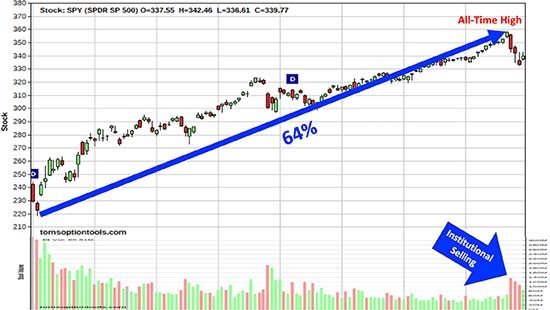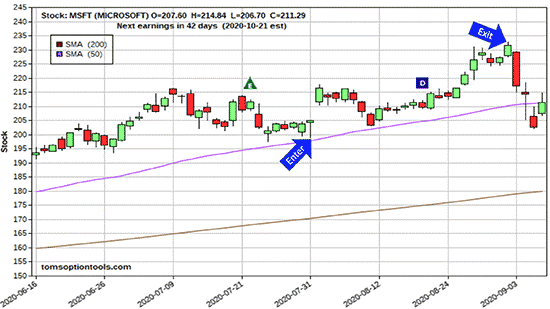A UBS study not long ago polled 3,750 investors, and 81% are predicting another market crash before the end of the year. The average drop of the predictions? Thirty-five percent.
Now, I'm usually not one to run with a crowd, but in this case... Well, even the most bullish optimists out there in Sunshine Town have to admit, the risks are there, and pretty easy to see.
We've got a potentially chaotic, drawn-out presidential election in November, which is right around the time experts agree cooler weather could bring worse COVID-19 outbreaks. We've got tensions with Iran; China and India have a bone to pick with each other, too. And, any given hour of the day or night, a provocative tweet from the White House could upend any and everything, really.
The 10% dip the Nasdaq took last week could be just an appetizer. Any one or a combination of those things could send stocks tumbling just as low, or lower, than we saw in March.
Look, I'm not saying this to spoil your good time. And I'm not saying it's time to head for the hills - not by a long shot.
But it is the perfect time to look at some inexpensive and, in some cases, potentially very profitable ways to fortify our portfolios and any long-term positions we might like to have on.
These moves will work if we have another crash, but they'll also pay off if we get another big gap downward like last week's, which could be even be more likely than a flat-out crash.
Here's what to do...
The Market Is Actually Telling Us What's Next
Let's spend a minute to digest what the recent "correction-like" drop told us.
Volume was high, which suggests that institutions were dumping stocks all over. Last Wednesday, there was a bump on the big indexes, but the sheer amount of stocks being bought and sold was nowhere near what it had been. That's telling me enthusiasm is pretty cool, and that the bears are still out there.
GOT TOXIC STOCKS? You very well could. Some of the most dangerous, wealth-wrecking shares are also some of the most popular picks out there. Click here to see if yours are mentioned in this "lightning round"...
More than that, the indexes have only moved up 2% and 3% in the seven or eight sessions since they dropped; that makes me a little uneasy from a bullish point of view. It might be the start of a renewed bull run, but it seems more like a couple of sessions of cautious bargain-hunting. The volume still isn't convincing me, at least as of 1 p.m. on Tuesday.
The bottom line is that more downside is likely. And believe me, it's way overdue. You can see from the graph below that the S&P 500 has risen a whopping 64% to an all-time high since bottoming on March 23, 2020.

Again, is this the start of a bigger drop? I don't know.
It's important to remember that the market ebbs and flows. The past few years where it's gone (generally) up and up and up aren't "normal." A 64% jump in the middle of the worst economic crisis since the Great Depression isn't "normal," either.
As a trader, what you need to think about is your expectations for the long and the short term. It's perfectly fine to be extremely bullish in the long term and extremely bearish in the short term. Or maybe not so extreme, or maybe the other way around.
It's all good - as a trader, you have ways of making money no matter what the market does. You can cash in on a long-term bull run and a weeklong plunge and monster two-day rally and a cyclical downturn - and everything in between.
But there's probably more downside volatility in the immediate future.
What You Need to Know About Options
Smart investors are tightening up their stops, going to cash or risk-off assets like gold and precious metals. Not-so-smart investors are biting their nails and hoping it won't get worse.
WARNING: 22 MILLION SHARES of this stock change hands every day. Make sure you're nowhere near it. Click here...
Us option traders are drooling with anticipation - I know I am. You see, for option traders, volatility means big profits, and making money in a bearish market can be like shooting fish in a barrel.
Options provide the following benefits:
- You spend less, leverage more stock.
- You reduce risk.
- Most importantly, you increase your profit potential tenfold.
Let's start with some basics. There are two basic types of options: calls and puts.
A call option provides you the right, but not the obligation, to buy a specific stock at a specific price (strike) until a specific date (expiration).
Calls increase in value when the underlying stock moves up in price and decrease in value when a stock moves down in price.
A single call contract controls 100 shares of stock.
Today, let's compare a stock purchase to a call option purchase on Microsoft Corp. (NASDAQ: MSFT).

If you were to buy 100 shares of MSFT at $205 on 7/31/20, you'd spend $20,500
A MSFT Sept. 18, 2020 $205 call would cost $8.70 per share, or $870 to control 100 shares of MSFT. This call option expires on Sept. 18, the expiration date.
Right off the bat, we've reduced our risk by an astonishing $19,630 to control the same asset.
Had you sold your shares at MSFT's all-time-high of $232.86 on Sept. 9, 2020, you'd have profited $27.86 per share, or $2,786 (13.5% ROI).
That's okay... but, if you cashed out on your MSFT Sept. 18, 2020 $205 call on the same date, it was worth $2,700, a profit of $1,830 (210% ROI).

So the call option greatly outperformed the stock position, at 1/24 of the risk. Had MSFT tanked $25 like it just did last week, you'd have lost $2,500 on your stock position. But had the call moved against you, you'd have capped your loss at just $870.
Spend less, risk less, and make 10 times the profit on call options. To me, it's a no-brainer!
That's perfect for when you're expecting stocks to climb. Puts are what this market calls for, so let's move it along...
Put options profit when the underlying stock drops. This is perfect for the projected downside in the weeks ahead.
A put option provides you the right to sell a specific stock at a specific price (strike) until a specific date (expiration). Puts increase in value when the underlying stock moves down in price and vice versa.
PUBLIC SERVICE ANNOUNCEMENT from Money Morning: If you own these stocks, drop 'em like a bad habit. Learn more...
Just like calls, one put contract controls 100 shares of stock.
Puts are a lot like insurance; they can be used to protect stock in the same exact way. An insurance policy gives you the right to sell the asset at an agreed to price for an agreed to amount of time - same idea as a put.
If you must hold stock, consider protecting them with puts.
Let's take another look at MSFT.
On Sept. 9, 2020, MSFT hit an all-time high of $231.65. Three days later, the stock closed at $202.66, a $28.99 (12.4%) drop.
If you owned 100 shares, you'd be looking at a $2,899 loss.
On Sept. 9, a MSFT Oct. 2, 2020 $232.50 put would have run you $1,055 and given you the right to sell 100 shares of MSFT at $232.50.
Just three days later, this put option was worth $3,100 - a $2,045 increase (94% ROI). That would offset most of the loss in the stock, giving you the right to still sell the shares at $232.50.
The bottom line: Buy calls on stocks you think will go up, buy puts on stocks you think are poised to drop.
Because if we're right about a coming drop, put option positions will clean up.
Let me share a few simple rules of thumb - some general guidelines to keep in mind when you're thinking about putting on a put position or, as it's sometimes called, "going short."
How to Buy the Right Puts
Buy put options one or two strikes lower than the current stock price.
Give yourself time; buy your puts between 90 and 100 days before their expiration.
Consider buying puts on market index ETFs like the SPDR S&P 500 ETF (NYSE: SPY), SPDR Dow Jones Industrial Average ETF (NYSE: DIA), and the Invesco QQQ Trust (NYSE: QQQ).
Now that's a great profit-protective strategy, but it's possible for options to profit much faster than these, and faster than outright buying shares of stock.
This Options Strategy Delivers Instant Paydays... and More
I want to show you how to use a certain trading strategy that can put money in your pocket fast.
This can let you collect an up-front payment right away, but it can also get you into any stock you want to own, sometimes at a discount.
It's kind of like getting paid to buy stocks.
I can help walk you through this strategy step by step, and when I'm done, you could be on the road to building wealth faster than you ever thought possible.
Follow Money Morning on Facebook and Twitter.
About the Author
Tom Gentile, options trading specialist for Money Map Press, is widely known as America's No. 1 Pattern Trader thanks to his nearly 30 years of experience spotting lucrative patterns in options trading. Tom has taught over 300,000 traders his option trading secrets in a variety of settings, including seminars and workshops. He's also a bestselling author of eight books and training courses.



